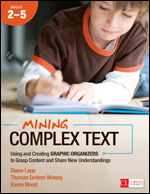Mining Complex Text, Grades 2-5
Using and Creating Graphic Organizers to Grasp Content and Share New Understandings
- Diane Lapp - San Diego State University, USA
- Thomas DeVere Wolsey
- Karen Wood - University of North Carolina, Charlotte, USA
Corwin Literacy
English/Language Arts Common Core | Literacy (Primary/Elementary) | Reading (Primary/Elementary)
“How many times have you heard ‘a picture is worth a thousand words.’ . . . In this text, Lapp, Wolsey, Wood, and Johnson make a vital connection between reading words and the role of graphics. They demonstrate how teachers and students can blend the two such that great learning occurs in every classroom, every day.”
—DOUGLAS FISHER
Coauthor of Rigorous Reading
Imagine you are a fourth grader, reading about our solar system for the first time. Or you’re a high school student, asked to compare survival in Suzanne Collin’s The Hunger Games and Elie Wiesel’s Night. Reading complex texts of any kind is arduous, and now more than ever, students are being asked to do highly advanced thinking, talking, and writing around their reading. If only there were ingenious new power tools that could give students the space to tease apart complex ideas in order to comprehend and to weld their understandings into a new whole.
Good news: such tools exist. In the two volumes, Mining Complex Texts, Grades 2-5 and 6-12, a formidable author team shares fresh ways to use the best digital and print graphic organizers in whole-class, small-group, and independent learning. Big believers of the gradual release method, the authors roll out dozens of examples of dynamic lessons and collaborative work across the content areas so that we see the process of using these visual tools to:
- Help students read, reread, and take notes on a text
- Promote students’ oral sharing of information and their ideas
- Elevate organized note-making from complex text(s)
- Scaffold students’ narrative and informational writing
- Move students to independent thinking as they learn to create their own organizing and note-taking systems
Gone are the days of fill-‘em-in and forget-‘em graphic organizers. With these two volumes, teachers and professional development leaders have a unified vision of how to use these tools to meet the demands of an information-saturated world, one in which students need to be able to sift, sort, synthesize, and apply knowledge with alacrity and skill.
“How many times have you heard ‘a picture is worth a thousand words.’ Visual, graphic information is important because human brains are hard-wired to attend to images. The challenge is that students still have to read words to achieve success. In this text, Lapp, Wolsey, Wood, and Johnson make a vital connection between reading words and the role of graphics. They demonstrate how teachers and students can blend the two such that great learning occurs in every classroom, every day.”
“Lapp, Wolsey, Wood, and Johnson have written a book that will become the resource for using graphic organizers across disciplines! With careful attention to the details teachers crave in order to design meaningful lessons, the authors guide teachers on a journey that takes them far beyond the traditional uses of graphic organizers—jotting notes and organizing information—and show teachers how these visual tools lead students to independent thinking and inquiry, as well as support the Common Core reading and writing standards. What I love about this book is that it fosters original thinking among students as they design graphic organizers that enable them to unpack meaning from complex texts and develop arguments for essays.”
“Professional books have long urged teachers to use graphic organizers, but most of these books are dreadfully short on specifics. Diane Lapp and her colleagues have addressed this problem in an admirable fashion. They examine with care the kinds of organizers available to teachers, together with when and how to use them. And by showing how organizers transcend disciplinary boundaries, the authors pave the way for a school-wide focus for professional learning. Educators endeavoring to meet the challenges of the Common Core should mark this title as a must-read. This engaging book is long overdue and I recommend it enthusiastically!”
“For educators looking for ways to implement graphic organizers in their classrooms, this is the resource for you. The numerous types of graphic organizers, the research behind them, and the how and why to use them with students are all at your fingertips. I envision this book being especially helpful for teachers new to the field just learning about graphic organizers.”

